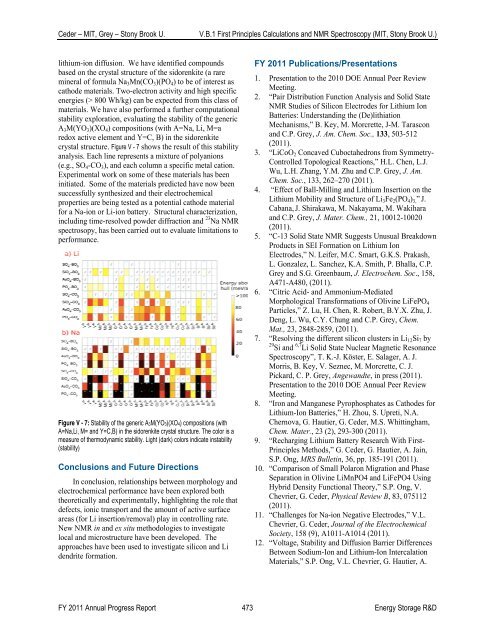V. Focused Fundamental Research - EERE - U.S. Department of ...
V. Focused Fundamental Research - EERE - U.S. Department of ...
V. Focused Fundamental Research - EERE - U.S. Department of ...
Create successful ePaper yourself
Turn your PDF publications into a flip-book with our unique Google optimized e-Paper software.
Ceder – MIT, Grey – Stony Brook U.<br />
V.B.1 First Principles Calculations and NMR Spectroscopy (MIT, Stony Brook U.)<br />
lithium-ion diffusion. We have identified compounds<br />
based on the crystal structure <strong>of</strong> the sidorenkite (a rare<br />
mineral <strong>of</strong> formula Na 3 Mn(CO 3 )(PO 4 ) to be <strong>of</strong> interest as<br />
cathode materials. Two-electron activity and high specific<br />
energies (> 800 Wh/kg) can be expected from this class <strong>of</strong><br />
materials. We have also performed a further computational<br />
stability exploration, evaluating the stability <strong>of</strong> the generic<br />
A 3 M(YO 3 )(XO 4 ) compositions (with A=Na, Li, M=a<br />
redox active element and Y=C, B) in the sidorenkite<br />
crystal structure. Figure V - 7 shows the result <strong>of</strong> this stability<br />
analysis. Each line represents a mixture <strong>of</strong> polyanions<br />
(e.g., SO 4 -CO 3 ), and each column a specific metal cation.<br />
Experimental work on some <strong>of</strong> these materials has been<br />
initiated. Some <strong>of</strong> the materials predicted have now been<br />
successfully synthesized and their electrochemical<br />
properties are being tested as a potential cathode material<br />
for a Na-ion or Li-ion battery. Structural characterization,<br />
including time-resolved powder diffraction and 23 Na NMR<br />
spectrosopy, has been carried out to evaluate limitations to<br />
performance.<br />
Figure V - 7: Stability <strong>of</strong> the generic A3M(YO3)(XO4) compositions (with<br />
A=Na,Li, M= and Y=C,B) in the sidorenkite crystal structure. The color is a<br />
measure <strong>of</strong> thermodynamic stability. Light (dark) colors indicate instability<br />
(stability)<br />
Conclusions and Future Directions<br />
In conclusion, relationships between morphology and<br />
electrochemical performance have been explored both<br />
theoretically and experimentally, highlighting the role that<br />
defects, ionic transport and the amount <strong>of</strong> active surface<br />
areas (for Li insertion/removal) play in controlling rate.<br />
New NMR in and ex situ methodologies to investigate<br />
local and microstructure have been developed. The<br />
approaches have been used to investigate silicon and Li<br />
dendrite formation.<br />
FY 2011 Publications/Presentations<br />
1. Presentation to the 2010 DOE Annual Peer Review<br />
Meeting.<br />
2. “Pair Distribution Function Analysis and Solid State<br />
NMR Studies <strong>of</strong> Silicon Electrodes for Lithium Ion<br />
Batteries: Understanding the (De)lithiation<br />
Mechanisms,” B. Key, M. Morcrette, J-M. Tarascon<br />
and C.P. Grey, J. Am. Chem. Soc., 133, 503-512<br />
(2011).<br />
3. “LiCoO 2 Concaved Cuboctahedrons from Symmetry-<br />
Controlled Topological Reactions,” H.L. Chen, L.J.<br />
Wu, L.H. Zhang, Y.M. Zhu and C.P. Grey, J. Am.<br />
Chem. Soc., 133, 262–270 (2011).<br />
4. “Effect <strong>of</strong> Ball-Milling and Lithium Insertion on the<br />
Lithium Mobility and Structure <strong>of</strong> Li 3 Fe 2 (PO 4 ) 3, ” J.<br />
Cabana, J. Shirakawa, M. Nakayama, M. Wakihara<br />
and C.P. Grey, J. Mater. Chem., 21, 10012-10020<br />
(2011).<br />
5. “C-13 Solid State NMR Suggests Unusual Breakdown<br />
Products in SEI Formation on Lithium Ion<br />
Electrodes,” N. Leifer, M.C. Smart, G.K.S. Prakash,<br />
L. Gonzalez, L. Sanchez, K.A. Smith, P. Bhalla, C.P.<br />
Grey and S.G. Greenbaum, J. Electrochem. Soc., 158,<br />
A471-A480, (2011).<br />
6. “Citric Acid- and Ammonium-Mediated<br />
Morphological Transformations <strong>of</strong> Olivine LiFePO 4<br />
Particles,” Z. Lu, H. Chen, R. Robert, B.Y.X. Zhu, J.<br />
Deng, L. Wu, C.Y. Chung and C.P. Grey, Chem.<br />
Mat., 23, 2848-2859, (2011).<br />
7. “Resolving the different silicon clusters in Li 12 Si 7 by<br />
29 Si and 6,7 Li Solid State Nuclear Magnetic Resonance<br />
Spectroscopy”, T. K.-J. Köster, E. Salager, A. J.<br />
Morris, B. Key, V. Seznec, M. Morcrette, C. J.<br />
Pickard, C. P. Grey, Angewandte, in press (2011).<br />
Presentation to the 2010 DOE Annual Peer Review<br />
Meeting.<br />
8. “Iron and Manganese Pyrophosphates as Cathodes for<br />
Lithium-Ion Batteries,” H. Zhou, S. Upreti, N.A.<br />
Chernova, G. Hautier, G. Ceder, M.S. Whittingham,<br />
Chem. Mater., 23 (2), 293-300 (2011).<br />
9. “Recharging Lithium Battery <strong>Research</strong> With First-<br />
Principles Methods,” G. Ceder, G. Hautier, A. Jain,<br />
S.P. Ong, MRS Bulletin, 36, pp. 185-191 (2011).<br />
10. “Comparison <strong>of</strong> Small Polaron Migration and Phase<br />
Separation in Olivine LiMnPO4 and LiFePO4 Using<br />
Hybrid Density Functional Theory,” S.P. Ong, V.<br />
Chevrier, G. Ceder, Physical Review B, 83, 075112<br />
(2011).<br />
11. “Challenges for Na-ion Negative Electrodes,” V.L.<br />
Chevrier, G. Ceder, Journal <strong>of</strong> the Electrochemical<br />
Society, 158 (9), A1011-A1014 (2011).<br />
12. “Voltage, Stability and Diffusion Barrier Differences<br />
Between Sodium-Ion and Lithium-Ion Intercalation<br />
Materials,” S.P. Ong, V.L. Chevrier, G. Hautier, A.<br />
FY 2011 Annual Progress Report 473 Energy Storage R&D



